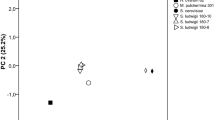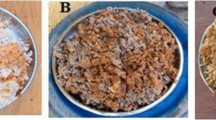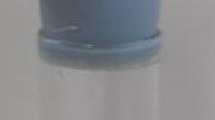Abstract
This work was performed to verify the potential of yeast strains isolated from cachaça distilleries for two specific biotechnological applications: beer and bioethanol production. In the beer production, the strains were tested for characteristics required in brewery practices, such as: capacity to ferment maltose and maltotriose, ability to grow at lowest temperatures, low H2S production, and flocculation profile. Among the strains tested, two of them showed appropriate characteristics to produce two different beer styles: lager and ale. Moreover, both strains were tested for cachaça production and the results confirmed the capacity of these strains to improve the quality of cachaça. In the bioethanol production, the fermentation process was performed similarly to that used by bioethanol industries: recycling of yeast biomass in the fermentative process with sulfuric acid washings (pH 2.0). The production of ethanol, glycerol, organic acids, dry cell weight, carbohydrate consumption, and cellular viability were analyzed. One strain presented fermentative parameters similar to PE2, industrial/commercial strain, with equivalent ethanol yields and cellular viability during all fermentative cycles. This work demonstrates that cachaça distilleries seem to be an interesting environment to select new yeast strains to be used in biotechnology applications as beer and bioethanol production.





Similar content being viewed by others
References
Alfenore S, Molina-Jouve C, Guillouet S, Uribelarrea J-L, Goma G, Benbadis L (2002) Improving ethanol production and viability of Saccharomyces cerevisiae by a vitamin feeding strategy during fed-batch process. Appl Microbiol Biotechnol 60:67–72
Alvarez F, Correa LFdM, Araújo TM, Mota BEF, Conceição LEFR, Castro IM, Brandão RL (2014) Variable flocculation profiles of yeast strains isolated from cachaça distilleries. Int J Food Microbiol 190:97–104
Alves SL, Herberts RA, Hollatz C, Trichez D, Miletti LC, De Araujo PS, Stambuk BU (2008) Molecular analysis of maltotriose active transport and fermentation by Saccharomyces cerevisiae reveals a determinant role for the AGT1 permease. Appl Environ Microbiol 74:1494–1501
Amorim HV, Lopes ML, de Castro Oliveira JV, Buckeridge MS, Goldman GH (2011) Scientific challenges of bioethanol production in Brazil. Appl Microbiol Biotechnol 91:1267–1275
Andrietta MGS, Stupiello ÉNA, Andrietta SR (2011) Bioethanol-what has Brazil learned about yeasts inhabiting the ethanol production processes from sugar cane? In: Bernardes MAS (ed) Biofuel production-recent developments and prospects. INTECH Open Access, pp 67–84
Andrietta SR, Andrietta MGS, Bicudo MHP (2012) Comparação do rendimento fermentativo utilizando diferentes metodologias de cálculo para a avaliação do desempenho de um processo industrial. Sociedade dos Técnicos Açucareiros e Alcooleiros do Brasil 30:41–49
Badotti F, Vilaça ST, Arias A, Rosa CA, Barrio E (2014) Two interbreeding populations of Saccharomyces cerevisiae strains coexist in cachaça fermentations from Brazil. FEMS Yeast Res 14:289–301
Barbosa EA et al (2016) Quality improvement and geographical indication of cachaça (Brazilian spirit) by using locally selected yeast strains. J Appl Microbiol 121:1038–1051
Barros-Lopes M, Bellon JR, Shirley NJ, Ganter PF (2002) Evidence for multiple interspecific hybridization in Saccharomyces sensu stricto species. FEMS Yeast Res 1:323–331
Basso LC, Rocha SN, Basso TO (2011) Ethanol production in Brazil: the industrial process and its impact on yeast fermentation. In: Bernardes MAdS (ed) Biofuel production-recent developments and prospects. INTECH, Croatia, pp 85–100
Brányik T, Vicente AA, Dostálek P, Teixeira JA (2008) A review of flavour formation in continuous beer fermentations. J Inst Brew 114:3–13
Brazil (2005) Instrução Normativa nº 13 vol Instrução Normativa nº 13. Diário Oficial da União, Brasilia
Bussey H, Umbarger HE (1970) Biosynthesis of the branched-chain amino acids in yeast: a leucine-binding component and regulation of leucine uptake. J Bacteriol 103:277–285
Conceição LE et al (2015) Biotechnological potential of yeast isolates from cachaca: the Brazilian spirit. J Ind Microbiol Biotechnol 42:237–246. https://doi.org/10.1007/s10295-014-1528-y
Dequin S (2001) The potential of genetic engineering for improving brewing, wine-making and baking yeasts. Appl Microbiol Biotechnol 56:577–588
D’Hautcourt O, Smart KA (1999) Measurement of brewing yeast flocculation. J Am Soc Brew Chem 57:123–128
Ekunsanmi T, Odunfa S (1990) Ethanol tolerance, sugar tolerance and invertase activities of some yeast strains isolated from steep water of fermenting cassava tubers. J Appl Bacteriol 69:672–675
Faria-Oliveira F, Diniz RH, Godoy-Santos F, Piló FB, Mezadri H, Castro IM, Brandão RL (2015) The role of yeast and lactic acid bacteria in the production of fermented beverages in South America. In: Eissa AHA (ed) Food production and industry. Intech, Croatia, pp 107–135
Figueiredo BIC, Saraiva MAF, Pimenta PPS, Testasicca MCS, Afonso LCC, Sampaio GMS, Castro IM, Brandão RL (2017) New lager brewery strains obtained by crossing techniques using cachaça (Brazilian spirit) yeast strains. Appl Environ Microbiol 83(20):e01582
Gallone B et al (2016) Domestication and divergence of Saccharomyces cerevisiae beer yeasts. Cell 166(1397–1410):e1316
González SS, Gallo L, Climent MD, Barrio E, Querol A (2007) Enological characterization of natural hybrids from Saccharomyces cerevisiae and S. kudriavzevii. Int J Food Microbiol 116:11–18
González SS, Barrio E, Querol A (2008) Molecular characterization of new natural hybrids of Saccharomyces cerevisiae and S. kudriavzevii in brewing. Appl Environ Microbiol 74:2314–2320
Haase SB, Reed SI (2002) Improved flow cytometric analysis of the budding yeast cell cycle. Cell cycle 1:117–121
IBGE (2016) Instituto Brasileiro de Geografia e Estatística [Brazilian Institute of Geography and Statistics]. http://www.ibge.gov.br/. Accessed 11/10 2016
Ichikawa E, Hosokawa N, Hata Y, Abe Y, Suginami K, Imayasu S (1991) Breeding of a sake yeast with improved ethyl caproate productivity. Agric Biol Chem 55:2153–2154
Jiranek V, Langridge P, Henschke P (1995) Regulation of hydrogen sulfide liberation in wine-producing Saccharomyces cerevisiae strains by assimilable nitrogen. Appl Environ Microbiol 61:461–467
Kobayashi M, Shimizu H, Shioya S (2008) Beer volatile compounds and their application to low-malt beer fermentation. J Biosci Bioeng 106:317–323
Lee S, Robinson F, Wang H Rapid determination of yeast viability. In: Biotechnology and bioengineering symposium, Ann Arbor, 1981. vol CONF-810554-. University of Michigan
Libkind D et al (2011) Microbe domestication and the identification of the wild genetic stock of lager-brewing yeast. Proc Natl Acad Sci 108:14539–14544
Lõoke M, Kristjuhan K, Kristjuhan A (2011) Extraction of genomic DNA from yeasts for PCR-based applications. Biotechniques 50:325
Martini C, Margarido LAC, Ceccato-Antonini SR (2010) Microbiological and physicochemical evaluations of juice extracted from different parts of sugar cane stalks from three varieties cultivated under organic management. Food Sci Technol 30:808–813
Nakao Y et al (2009) Genome sequence of the lager brewing yeast, an interspecies hybrid. DNA Res 16:115–129
Oliveira VA et al (2008) Biochemical and molecular characterization of Saccharomyces cerevisiae strains obtained from sugar-cane juice fermentations and their impact in cachaca production. Appl Environ Microbiol 74:693–701. https://doi.org/10.1128/AEM.01729-07
Pagliardini J, Hubmann G, Alfenore S, Nevoigt E, Bideaux C, Guillouet SE (2013) The metabolic costs of improving ethanol yield by reducing glycerol formation capacity under anaerobic conditions in Saccharomyces cerevisiae. Microb Cell Fact 12:29
Pataro C, Guerra JB, Petrillo-Peixoto ML, Mendonça-Hagler LC, Linardi VR, Rosa CA (2000) Yeast communities and genetic polymorphism of Saccharomyces cerevisiae strains associated with artisanal fermentation in Brazil. J Appl Microbiol 89:24–31. https://doi.org/10.1046/j.1365-2672.2000.01092.x
Powell CD, Quain DE, Smart KA (2003) The impact of brewing yeast cell age on fermentation performance, attenuation and flocculation. FEMS Yeast Res 3:149–157
Querol A, Bond U (2009) The complex and dynamic genomes of industrial yeasts. FEMS Microbiol Lett 293:1–10
Saerens S, Delvaux F, Verstrepen K, Van Dijck P, Thevelein J, Delvaux F (2008) Parameters affecting ethyl ester production by Saccharomyces cerevisiae during fermentation. Appl Environ Microbiol 74:454–461
Saerens SM, Delvaux FR, Verstrepen KJ, Thevelein JM (2010) Production and biological function of volatile esters in Saccharomyces cerevisiae. Microb Biotechnol 3:165–177
Satyanarayana T, Umbarger H, Lindegren G (1968) Biosynthesis of branched-chain amino acids in yeast: regulation of leucine biosynthesis in prototrophic and leucine auxotrophic strains. J Bacteriol 96:2018–2024
Schwan RF, Mendonca AT, Silva JJ Jr, Rodrigues V, Wheals AE (2001) Microbiology and physiology of Cachaca (Aguardente) fermentations. Antonie Van Leeuwenhoek 79:89–96
Verstrepen K, Derdelinckx G, Verachtert H, Delvaux F (2003) Yeast flocculation: what brewers should know. Appl Microbiol Biotechnol 61:197–205
Vicente MA, Fietto LG, Castro IM, dos Santos AN, Coutrim MX, Brandao RL (2006) Isolation of Saccharomyces cerevisiae strains producing higher levels of flavoring compounds for production of “cachaça” the Brazilian sugarcane spirit. Int J Food Microbiol 108:51–59. https://doi.org/10.1016/j.ijfoodmicro.2005.10.018
Vidgren V, Multanen J-P, Ruohonen L, Londesborough J (2010) The temperature dependence of maltose transport in ale and lager strains of brewer’s yeast. FEMS Yeast Res 10:402–411
White TJ, Bruns T, Lee S, Taylor T (1990) Amplification and direct sequencing of fungal RNA genes for phylogenetic. In: Inn MA, Gelfrand DH, Sninsky JJ, With, TJ (eds) PCR protocols: a guide to methods and applications. Academic Press, New York
Yu Z, Zhao M, Li H, Zhao H, Zhang Q, Wan C, Li H (2012) A comparative study on physiological activities of lager and ale brewing yeasts under different gravity conditions. Biotechnol Bioprocess Eng 17:818–826
Acknowledgements
This work was supported by grants from Coordenação de Aperfeiçoamento de Pessoal de Nível Superior (CAPES/Brazil - Program AUXPE-DINTER 2499/2008); Fundação de Amparo à Pesquisa do Estado de Minas Gerais (FAPEMIG/Brazil - Process APQ-00209-12); and from Conselho Nacional de Desenvolvimento Científico e Tecnológico (CNPq/Brazil - Process 304815/2012-3 - research fellowship to RLB and Process 580185/2008-7). We are grateful to CNPEM and CTBE for helpful assistance with fermentation techniques and chromatographic analysis as well as to multiuser laboratories for mass spectrometry and microscopy: NUPEB, UFOP.
Author information
Authors and Affiliations
Corresponding author
Ethics declarations
Conflict of interest
All co-authors have seen and agreed with the content of the manuscript, and none of the co-authors have any financial interests to disclose.
Electronic supplementary material
Below is the link to the electronic supplementary material.
Rights and permissions
About this article
Cite this article
Araújo, T.M., Souza, M.T., Diniz, R.H.S. et al. Cachaça yeast strains: alternative starters to produce beer and bioethanol. Antonie van Leeuwenhoek 111, 1749–1766 (2018). https://doi.org/10.1007/s10482-018-1063-3
Received:
Accepted:
Published:
Issue Date:
DOI: https://doi.org/10.1007/s10482-018-1063-3




